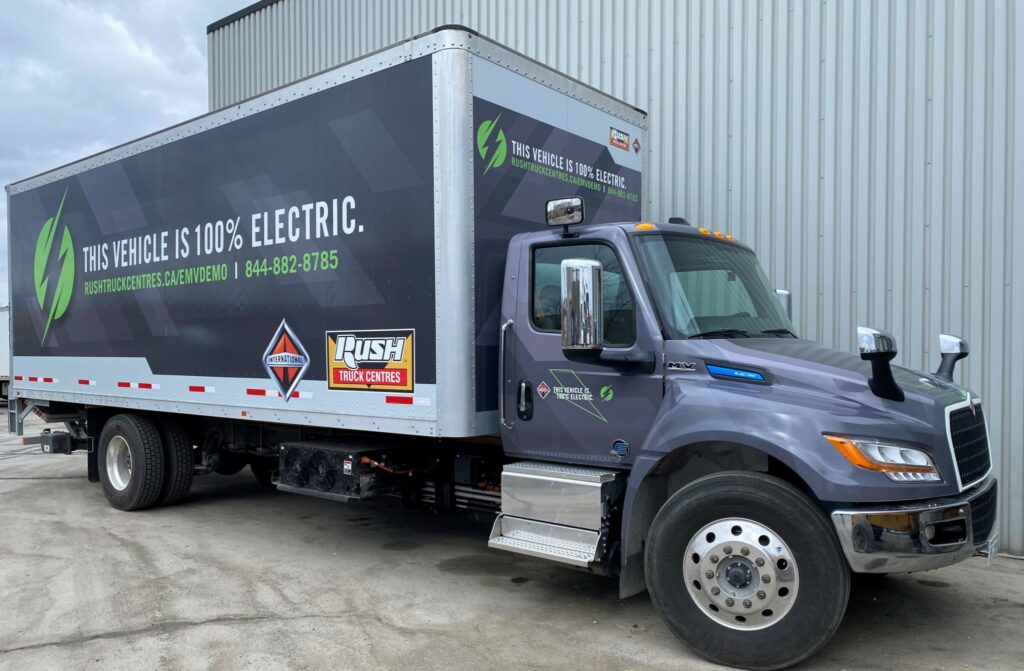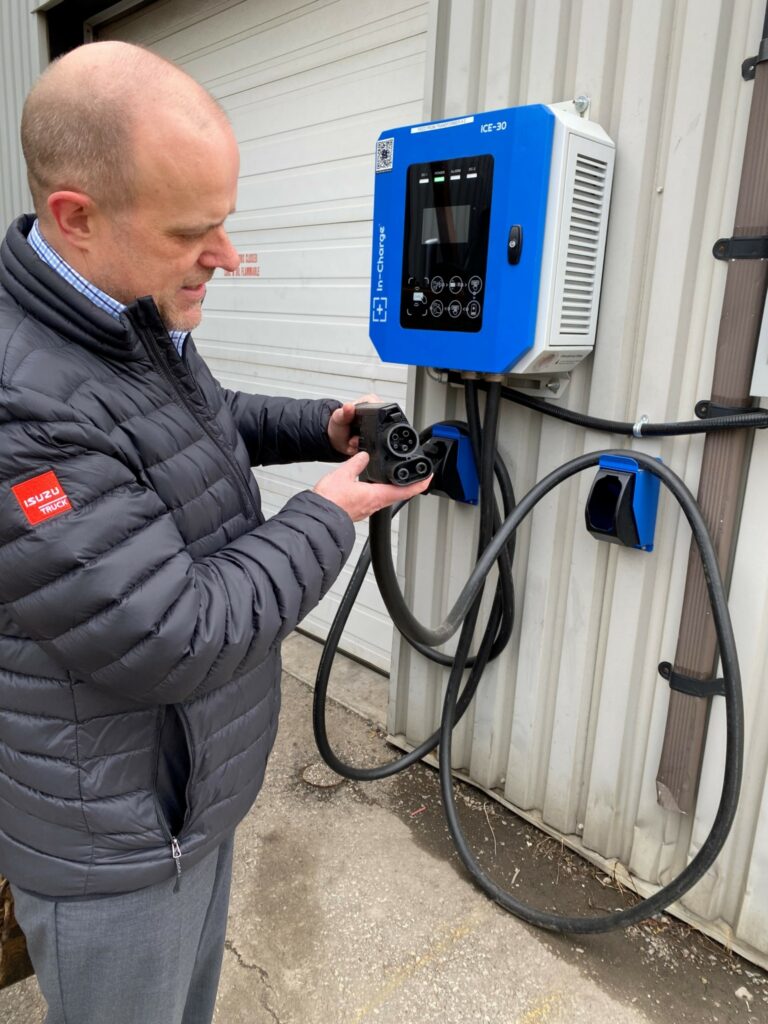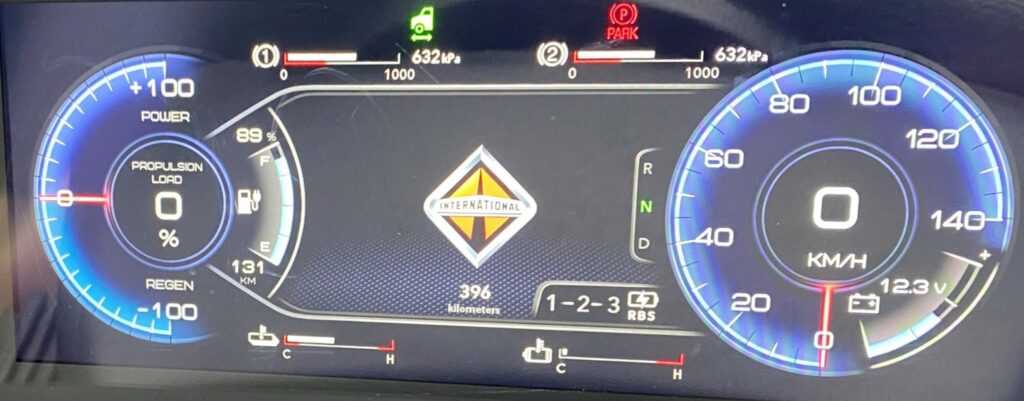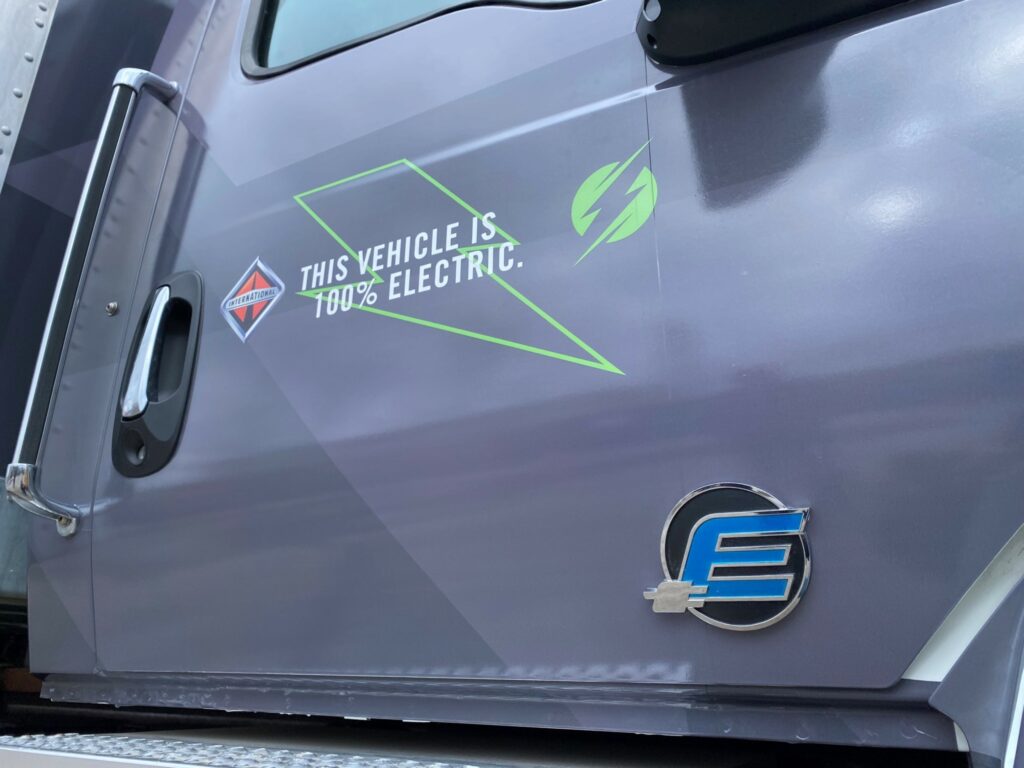Ontario’s first eMV set to begin customer trials
Ontario’s first all-electric International eMV has found a home at Rush Truck Centres in Mississauga, Ont., but it won’t be parked long before heading out on a busy demonstration tour.
We had the chance to see the truck and take it for a short drive as soon as the decals were applied and before it would go out to some 30-plus customers that have already requested time with the new vehicle. The set-back-axle eMV607 has a 26-foot dry van body on it, and will be tested under a wide range of applications.

Customers generally get a week to put the truck through its paces in their own application. But those customers must have charging availability on-site or nearby. Rush Truck Centres itself has installed two chargers – a 19.7 kW Level 2 AC and more robust 30 kW Level 3 DC charger – at its Mississauga location to support the introduction of electric vehicles.
Rush’s electric truck expert
Terry Maw, business development manager, has been appointed as Rush’s go-to electric truck guy. He has been busy prepping the Mississauga dealership for the arrival of EVs and has had to overcome certain challenges. Those you would think about (such as installing the chargers) and others you wouldn’t (such as having a ceiling height that allows the truck to be lifted high enough to access the batteries under the cab).

“You have to be able to lift the truck 10 feet in the air,” Maw told TruckNews.com. “Everything’s different.”
Rush has trained staff on electric trucks and has the support of OEM partner Navistar when it comes to consulting fleets on charger selection and installation. Now, the process of familiarizing customers with the eMV begins, and Maw said there’s already plenty of interest.
“I think there’s a market for it, it’s just a matter of awakening people to the availability of the trucks,” Maw said. “Some competitors won’t sell [electric trucks] – they’ll just lease them or let customers try them. We can produce them and sell them this year. We’re taking orders now.”
Funny enough, while the backlog for diesel-powered MV trucks stretches into next year, the eMV can be ordered today for delivery in about July, according to Dave Wallace, focus market manager with International Trucks, citing the lower volume demand for the electric version.
eMV demonstrations and applications
The demonstrations will see the eMV put into a range of applications. One customer is even testing it as mobile library that can be parked for lengthy periods of time without protesting during restarts like a diesel-powered truck might. But Maw said the best fits are city applications with frequent starting and stopping, which takes advantage of regenerative braking to extend battery life.
The upfront cost of an eMV exceeds that of a diesel model, but savings are accrued over time due to lower fueling and charging costs, along with reduced maintenance and brake wear. There are no oil changes or related filters to worry about, or general engine maintenance requirements.

There are three levels of regenerative braking available, and I tried each on the road. Level 3 is aggressive enough to minimize the required use of the brake pedal except to come to a complete stop. Level 1 is more subtle, feeling comparable to a soundless engine brake.
Like all electric trucks, silence is golden. The radio was audible at a low setting, conversation was easy, and the constant companion of the diesel’s rumble wasn’t missed. It’s a great truck for city drivers who are in and out of the vehicle all day.
eMV torque and power
As with other electric vehicles, torque is instant and beyond adequate. However, Maw said the calibrations have been set to mimic the performance and power of a 6.7L Cummins diesel, the traditional MV spec’, so that it’s not overpowered or a major adjustment for drivers.
The Dana TM4 Sumo electric motor is rates at 255 kW, giving the vehicle a range of about 215 km “conservatively,” Maw says. Some skilled use of regenerative braking will take it closer to 300 km between charges.
The Level 2 DC charger can get juice the batteries up from 0 to full in about four hours. The In-Charge branded charger can accommodate two vehicles at a time. When one is completely charged it will begin charging the other, so two vehicles can be charged overnight without manually unplugging one and plugging in the other.
The charging requirements remain the biggest unknown for fleets interested in electrifying, Maw noted. That’s where Navistar consultants can be called on to do a site visit and make recommendations. The truck maker also has experts available to seek out financial incentives for everything from the chargers to the trucks themselves.
“We’re still bushwhacking,” Maw said of the experience. “Everything is new.”

Cold weather and payloads
Rush is also working with its U.S. dealers to compare notes on deployment and marketing. The trucks here and there even share the same decaling, which boldly pronounces it’s a zero-emissions electric vehicle.
Maw said International Trucks doesn’t have any concerns about cold weather operations. The first two eMVs sold into Canada are based in Edmonton and performing well, he said, adding extreme heat can be more challenging for batteries than the cold. A thermal management system housed under the frame on the passenger side is designed to keep the batteries at the right temperature, regardless of the ambient weather.
Customers can use an app to monitor the charging status and location of the trucks. But the big limitation of the eMV is payload. The truck is rated at 33,000 lb., but tips the scales at just under 20,000 lb. due to the battery weight. This gives it a payload of just 13,000 lb. when equipped with a 26-foot box.
That still works for some customers, though. For those requiring heavier payload, Maw noted battery weight, cost, and power density is continuously being improved.
Have your say
This is a moderated forum. Comments will no longer be published unless they are accompanied by a first and last name and a verifiable email address. (Today's Trucking will not publish or share the email address.) Profane language and content deemed to be libelous, racist, or threatening in nature will not be published under any circumstances.
AND THE PRICE +GRANTS+ LOW INTEREST LOANS
+ INSTALLATION OF CHARGERS
TOTAL COST DAY ONE ON THE ROAD
THAT IS THE QUESTION
ROAD TESTS ON A REGULAR ROUTE IN EDMONTON WINNIPEG MONTREAL NORTHERN ONTARIO
Yes, zero emissions while driving it, but charging it and the emissions caused by the manufacturing of the batteries will far outrank the zero emissions savings!